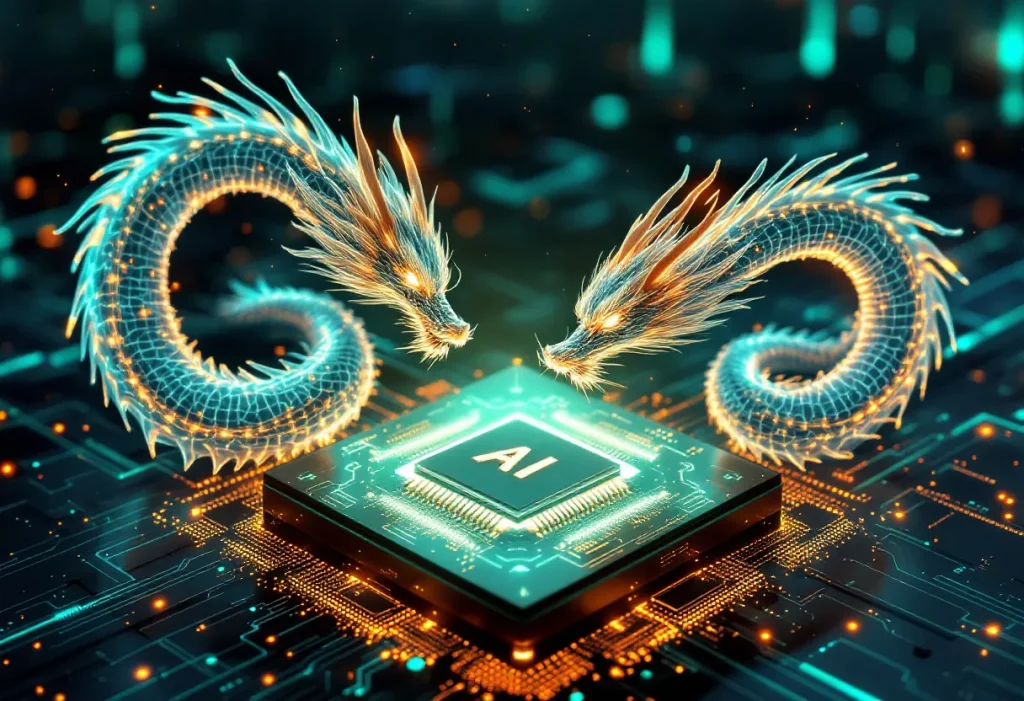Successor to the Deepseek R1, which had already impressed with its capabilities, this new iteration of the Deepseek AI model could well mark a decisive turning point in the generative AI race. Scheduled for early May 2025, this Chinese model could well reshuffle the cards in a market hitherto dominated by American giants.
Deepseek R2 combines phenomenal computing power with revolutionary energy efficiency, while cutting running costs by a factor of up to 40 compared to some direct competitors.
Let’s discover together what makes Deepseek R2 one of the most promising technological innovations of the decade.

The revolutionary architecture of Deepseek R2
The real revolution in Deepseek R2 lies in its novel approach to artificial intelligence architecture.
Instead of simply increasing the number of parameters, as most competitors do, Deepseek has opted for a radically different strategy.
A game-changing “Hybrid MoE 3.0” approach
The heart of Deepseek R2 is its Hybrid Mixture-of-Experts (MoE) 3.0 architecture, a system that propels efficiency to previously unimaginable levels.
Concretely, the model has a gargantuan network of 1.2 trillion parameters, but – and this is where all the genius lies – it only activates between 78 and 96 billion of them during each processing. This represents only 6.5 to 8% of the total.
This intelligent architecture enables:
- Multiply processing speed without sacrificing quality
- Drastically reduce energy consumption
- Lower operating costs by up to 97% compared with GPT-4 Turbo
- Dynamically adapt resources according to the nature of the task (text, image, code, etc.)
This hybrid architecture allows Deepseek R2 to achieve a perfect balance between raw power and efficiency, where most models have to sacrifice one to achieve the other.
A 100% Chinese hardware infrastructure
Another notable fact: unlike the majority of Western AI models that rely on Nvidia chips, Deepseek R2 has been trained entirely on Huawei Ascend 910B chips.
This infrastructure achieves an impressive 512 PetaFLOPS of computing power in FP16 precision.
Strategic partnerships with Tuowei Information and Sugon for liquid cooling have also optimized the system’s energy efficiency.
According to the data provided by Deepseek, this configuration rivals Nvidia A100 clusters while cutting the unit cost of drive by almost a factor of three.
This technological independence from US components is a major asset in the current geopolitical context, at a time when local installation and use of AI models is gaining in popularity in the face of export restrictions on advanced chips to China.
Multimodal capabilities and advanced reasoning
Deepseek R2 isn’t just technically impressive – its real-world performance on a variety of complex tasks testifies to a genuine qualitative breakthrough.
Exceptional contextual processing and speed
Thanks to the implementation of advanced techniques such as YaRN (Yet another RoPE extension), Deepseek R2 can process up to 128,000 tokens in a single query.
This particularly wide context window makes it ideal for fields requiring analysis of voluminous documents such as law, finance or academic research.
In terms of sheer speed, the model impresses with throughputs in excess of 1,200 tokens per second – a crucial parameter for real-time applications and conversational assistants.
Excellence in computer vision
The multimodal dimension of Deepseek R2 is not limited to text. On the COCO dataset, the benchmark for computer vision, it boasts an object segmentation score of 92.4 mAP, outperforming the previous standard, CLIP, by 11.6 points.
This ability to precisely understand and analyze images, combined with its linguistic prowess, paves the way for extremely sophisticated applications such as:
- Automated analysis of complex graphical documents
- The generation of detailed reports from medical imaging
- Processing rich multimedia content for marketing or education
Native multilingualism and advanced reasoning
In contrast to many models mainly trained on English-language corpora, Deepseek R2 benefits from training on massive multilingual datasets.
This inclusive approach strengthens its reliability for global uses and improves its performance on languages traditionally less well served by AI.
In pure reasoning, the model particularly excels in logic, mathematics and programming, surpassing benchmarks set by its predecessors and direct competitors.
Revolutionary cost-effectiveness
One of the most revolutionary aspects of Deepseek R2 lies in its economy of use. With a claimed cost of $0.07 per million tokens in input, it is positioned as nearly forty times more efficient than some premium competitors.
This affordability, combined with its high-flying performance, could democratize access to advanced AI for:
- Startups and SMEs with limited resources
- Researchers and academic institutions
- Emerging markets hitherto excluded by prohibitive costs
The combination of superior computing power and drastically reduced costs could make Deepseek R2 the catalyst for a new wave of AI innovation, particularly in hitherto underrepresented regions.
## Potential impact on the global AI market
If its announced performance is confirmed on release, Deepseek R2 could well upset the balance of power in the global AI ecosystem.
Its unique combination of power, efficiency and affordability makes it a formidable competitor to established models such as GPT-4, Claude 3 or Gemini.
For companies and developers, the arrival of this new player could mean:
- A welcome diversification of the technological offering
- Downward pressure on AI service rates
- New possibilities for applications hitherto constrained by the limitations of existing models
- Easier access to cutting-edge AI for emerging markets
American domination of the generative AI sector could thus see its first real challenger, from China’s rapidly expanding technology ecosystem.
A major turning point for global AI
Deepseek R2 represents much more than just a technological iteration – it embodies a genuine breakthrough in the very approach to designing advanced AI models.
By prioritizing efficiency and architectural intelligence over simply increasing raw power, Deepseek potentially paves the way for a new generation of models that are greener, more accessible and ultimately more useful.
FAQ
When will Deepseek R2 be available to the public?
According to current information, the official launch of Deepseek R2 is scheduled for early May 2025. However, as with any major technological development, this date may be subject to change.
How does Deepseek R2 compare with GPT-4 Turbo and other leading models?
Based on preliminary data, Deepseek R2 outperforms GPT-4 Turbo on several reasoning and visual comprehension benchmarks, while offering superior inference speed and drastically reduced running costs (up to 97% cheaper). However, these comparisons will need to be confirmed by independent testing at official release.
What is the “Hybrid MoE 3.0” architecture and why is it important?
The Hybrid MoE (Mixture-of-Experts) 3.0 architecture is a system that allows the model to activate only a small fraction of its total parameters (6.5-8%) for each task. This provides the advantages of a massive model (1.2 trillion parameters) without the usual drawbacks in terms of cost and slowness. It’s this innovation that makes Deepseek R2 both more powerful and more efficient than its competitors.
Will Deepseek R2 be available from Europe and the USA?
Although Deepseek is a Chinese company, it plans to make its R2 model globally accessible. However, current geopolitical restrictions on AI technologies could potentially affect its availability in certain regions. Final details will be announced at the official launch.
What are the most promising practical applications for Deepseek R2?
Domains where Deepseek R2 could excel include the processing of complex legal and financial documents, advanced multimodal analysis (text + image), assisted programming, scientific research, and sophisticated conversational assistants. Its ability to process 128,000 tokens makes it particularly suited to tasks requiring the analysis of very long texts.
How does Deepseek R2 handle languages other than English?
In contrast to many AI models primarily optimized for English, Deepseek R2 has been trained on massive multilingual datasets. This approach, coupled with reinforcement learning techniques adapted to non-English languages, gives it superior performance in a wide range of languages.
What hardware specifications are required to run Deepseek R2 locally?
The full specifications for local execution have not yet been officially released. However, thanks to its efficient architecture, Deepseek R2 should require fewer resources than comparable models for similar performance. More information should be available closer to launch.
Will Deepseek R2 be offered via an API or direct access?
Deepseek plans to offer R2 both via a cloud API (for simplified deployment) and as a downloadable version for users wishing to host it on their own infrastructures. This dual approach aims to maximize flexibility of use according to users’ specific needs.
What security and privacy measures does Deepseek have in place?
Deepseek says it has implemented strict data protection protocols in R2’s design, including end-to-end encryption and private deployment options. The company is also committed to complying with regional data protection regulations such as the RGPD in Europe.
AI NEWSLETTER
Stay on top of AI with our Newsletter
Every month, AI news and our latest articles, delivered straight to your inbox.

CHATGPT prompt guide (EDITION 2024)
Download our free PDF guide to crafting effective prompts with ChatGPT.
Designed for beginners, it provides you with the knowledge needed to structure your prompts and boost your productivity
With this ebook, you will:
✔ Master Best Practices
Understand how to structure your queries to get clear and precise answers.
✔ Create Effective Prompts
The rules for formulating your questions to receive the best possible responses.
✔ Boost Your Productivity
Simplify your daily tasks by leveraging ChatGPT’s features.
Similar posts
DeepSeek r1: The free AI model that challenges market leaders
DeepSeek R1, a new open source LLM developed in China, is attracting unprecedented interest. This revolutionary model not only technically rivals giants such as GPT-4 or Claude 3.5, it offers …
Installing DeepSeek-R1 locally with LM Studio : Complete Guide
Local installation of DeepSeek-R1 offers a powerful solution for taking advantage of this model’s advanced capabilities while retaining full control over your data. Thanks to LM Studio, a user-friendly interface, …
Genspark AI: Revolutionizing search and automation with an intelligent super agent
In the tumultuous world of artificial intelligence, Genspark AI is emerging as a disruptive player. This “super agent” combines an innovative technical architecture, unprecedented automation capabilities and a radical approach …


